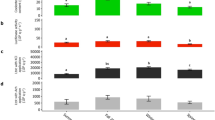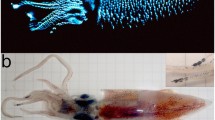Abstract
Sponges (phylum Porifera) represent a successful animal taxon that evolved prior to the Ediacaran-Cambrian boundary (542 million years ago). They have developed an almost complete array of cell- and tissue-based interaction systems necessary for the establishment of a functional, multicellular body. However, a network of neurons, one cell/tissue-communication system is missing in sponges. This fact is puzzling and enigmatic, because these animals possess receptors known to be involved in the nervous system in evolutionary younger animal phyla. As an example, the metabotropic glutamate/GABA-like receptor has been identified and cloned by us. Recently, we have identified a novel light transmission/light responsive system in sponges that is based on their skeletal elements, the siliceous glass fibers, termed spicules. Two classes of sponges, the Hexactinellida and the Demospongiae, possess a siliceous skeleton that is composed of spicules. Studying the large spicules from hexactinellid sponges (>5 cm) revealed that these spicules are effective light-collecting optical fibers. Now we can report that the demosponge, Suberites domuncula, has a biosensor system consisting of the (organic) light producing luciferase and the (inorganic) light transducing silica spicules. The light transmission features of these smaller spicules (200 μm) has been demonstrated and the ability of the sponge tissue to generate light had been proven. Screening for a luciferase gene in S. domuncula was successful. In the next step, we searched for a protein potentially involved in light reception. Such a protein was identified, cloned and recombinantly expressed from S. domuncula. The protein sequence displays two domains characteristic of a cryptochrome, the N-terminal photolyase-related region and the C-terminal FAD-binding domain. The experimental data indicate that sponges may employ a network of luciferase-like proteins, a spicular system and a cryptochrome as the light source, optical waveguide and photosensor, respectively. Finally, we have identified a potential transcription factor involved in the control of the expression of luciferase and cryptochrome, a SOX-related protein. We assume that a flashing light signaling circuit exists, which may control the retinoic acid-induced differentiation of stem cells into pulsating and contracting sponge cells, and into pinacocytes and myocytes. Such a “nervous”-like signal transduction system has not been previously described.
Article PDF
Similar content being viewed by others
Avoid common mistakes on your manuscript.
References
Müller W E G, Li J, Schröder H C, et al. The unique skeleton of siliceous sponges (Porifera; Hexactinellida and Demospongiae) that evolved first from the Urmetazoa during the Proterozoic: A review. Biogeosciences, 2007, 4: 219–232
Wang X H, Hu S, Gan L, et al. Sponges (Porifera) as living metazoan witnesses from the Neoproterozoic: Biomineralization and the concept of their evolutionary success. Terra Nova, 2010, 22: 1–11
Müller W E G, Wiens M, Adell T, et al. The Bauplan of the Urmetazoa: The basis of the genetic complexity of Metazoa using the siliceous sponges [Porifera] as living fossils. Int Rev Cytol, 2004, 235: 53–92
Müller W E G, Wang X H, Cui F Z, et al. Sponge spicules as blueprints for the biofabrication of inorganic-organic composites and biomaterials. Appl Microbiol Biotechnol, 2009, 83: 397–413
Wang X H, Schröder H C, Müller W E G. Giant siliceous spicules from the deep-sea glass sponge Monorhaphis chuni: Morphology, biochemistry and molecular biology. Int Rev Cell Mol Biol, 2009, 273: 69–115
Morse D E. Silicon biotechnology: Harnessing biological silica production to construct new materials. Trends Biotechnol, 1999, 17: 230–232
Müller W E G. Silicon Biomineralization: Biology-Biochemistry-Molecular Biology-Biotechnology. Berlin: Springer Press, 2003
Krasko A, Batel R, Schröder H C, et al. Expression of silicatein and collagen genes in the marine sponge Suberites domuncula is controlled by silicate and myotrophin. Europ J Biochem, 2000, 267: 4878–4887
Wiens M, Belikov S I, Kaluzhnaya O V, et al. Axial (apical-basal) expression of pro-apoptotic and pro-survival genes in the Lake Baikal demosponge Lubomirskia baicalensis. DNA Cell Biol, 2006, 25: 152–164
Müller W E G, Wendt K, Geppert C, et al. Novel photoreception system in sponges? Unique transmission properties of the stalk spicules from the hexactinellid Hyalonema sieboldi. Biosens Bioelectron, 2006, 21: 1149–1155
Wang X H, Li J, Qiao L, et al. Structure and characteristics of giant spicules of the deep sea hexactinellid sponges of the genus Monorhaphis (Hexactinellida: Amphidiscosida: Monorhaphididae). Acta Zool Sin, 2007, 53: 557–569
Harvey E N. Studies on bioluminescence. XIII. Luminescence in the coelenterates. Biol Bull, 1921, 41: 280–284
Belas R, Mileham A, Cohn D, et al. Bacterial bioluminescence: Isolation and expression of the luciferase genes from Vibrio harveyi. Science, 1982, 218: 791–793
Hervant F, Mathieu J, Barre H. Comparative study on the metabolic responses of subterranean and surface-dwelling amphipods to longterm starvation and subsequent refeeding. J Exp Biol, 1999, 202: 3587–3595
Alieva N O, Konzen K A, Field S F, et al. Diversity and evolution of coral fluorescent proteins. PLoS One, 2008, 3: e2680
Wiens M, Grebenjuk V A, Schröder H C, et al. Identification and isolation of a retrotransposon from the Lubomirskia baicalensis: Implication in rapid evolution of endemic sponges. Prog Mol Subcell Biol, 2009, 47: 207–234
Müller W E G, Belikov S I, Kaluzhnaya O V, et al. Cold stress defense in the freshwater sponge Lubomirskia baicalensis: Role of okadaic acid produced by symbiotic dinoflagellates. FEBS J, 2006, 274: 23–36
Wilson T, Hastings J W. Bioluminescence. Annu Rev Cell Dev Biol, 1998, 14: 197–230
Ridley S O, Dendy A. Report on the Monaxonida collected by H.M.S. ‘Challenger’. Report on the Scientific Results of the Voyage of the H.M.S. Challenger During the Years 1873-76. Vol. 20. London: Eyre & Spottiswoode, 1887
Leys S P, Mackie G O, Reiswig H M. The biology of glass sponges. Adv Mar Biol, 2007, 52: 1–145
Müller W E G, Wang X H, Burghard Z, et al. Bio-sintering processes in hexactinellid sponges: Fusion of bio-silica in giant basal spicules from Monorhaphis chuni. J Struct Biol, 2009, 168: 548–561
Strehler B L, McElroy W D. Purification of firefly luciferin. J Cell Physiol, 1949, 34: 457–466
Meighen E A. Molecular biology of bacterial bioluminescence. Microbiol Rev, 1991, 55: 123–142
Greer L F, Szalay A A. Imaging of light emission from the expression of luciferase in living cells and organisms: A review. Luminescence, 2002, 17: 43–74
Müller W E G, Kasueske M, Wang X H, et al. Luciferase a light source for the silica-based optical waveguides (spicules) in the demosponge Suberites domuncula. Cell Mol Life Sci, 2009, 66: 537–552
Branchini B R, Ablamsky D M, Murtiashaw M H, et al. Thermostable red and green light-producing firefly luciferase mutants for bioluminescent reporter applications. Anal Biochem, 2007, 361: 253–262
Gomi K, Kajiyama N. Oxyluciferin, a luminescence product of firefly luciferase, is enzymatically regenerated into luciferin. J Biol Chem, 2001, 276: 36508–36513
Müller W E G, Wiens M, Batel R, et al. Establishment of a primary cell culture from a sponge: Primmorphs from Suberites domuncula. Marine Ecol Prog Ser, 1999, 178: 205–219
Müller W E G, Wang X, Schröder H C, et al. A cryptochrome-based photosensory system in the siliceous sponge Suberites domuncula (Demospongiae). FEBS J, 2010, 277: 1182–1201
Wiens M, Wang X, Unger A, et al. Flashing light signaling circuit in sponges: endogenous light generation after tissue ablation in Suberites domuncula. J Cell Biochem, 2010, 111: 1377–1389
Levy O, Dubinsky Z, Achituv Y. Photobehavior of stony corals: Responses to light spectra and intensity. J Exp Biol, 2003, 206: 4041–4049
Levy O, Appelbaum L, Leggat W, et al. Light-responsive cryptochromes from a simple multicellular animal, the coral Acropora millepora. Science, 2007, 318: 467–470
Sarma A S, Daum T, Müller W E G. Secondary metabolites from marine sponges: Part I: Origin and chemistry of new metabolites, and synthetic studies; Part II: Biological properties of new metabolites and physiological activities of avarol and related compounds isolated from Dysidea sp. Akademie gemeinnütziger Wissenschaften zu Erfurt. Berlin: Ullstein-Mosby Verlag, 1993. 1–168
Gehring W J, Ikeo K. Pax 6: Mastering eye morphogenesis and eye evolution. Trends Genet, 2009, 15: 371–377
Koopman P, Schepers G, Brenner S, et al. Origin and diversity of the Sox transcription factor gene family: Genome-wide analysis in Fugu rubripes. Gene, 2004, 328: 177–186
Wegner M. From head to toes: The multiple facets of SOX proteins. Nucleic Acids Res, 1999, 27: 1409–1420
Hagstrom S A, Pauer G J, Reid J, et al. SOX2 mutation causes anophthalmia, hearing loss, and brain anomalies. Am J Med Genet, 2005, 138: 95–98
Author information
Authors and Affiliations
Corresponding authors
Additional information
This article is published with open access at Springerlink.com
Rights and permissions
This article is published under an open access license. Please check the 'Copyright Information' section either on this page or in the PDF for details of this license and what re-use is permitted. If your intended use exceeds what is permitted by the license or if you are unable to locate the licence and re-use information, please contact the Rights and Permissions team.
About this article
Cite this article
Wang, X., Fan, X., Schröder, H.C. et al. Flashing light in sponges through their siliceous fiber network: A new strategy of “neuronal transmission” in animals. Chin. Sci. Bull. 57, 3300–3311 (2012). https://doi.org/10.1007/s11434-012-5241-9
Received:
Accepted:
Published:
Issue Date:
DOI: https://doi.org/10.1007/s11434-012-5241-9




